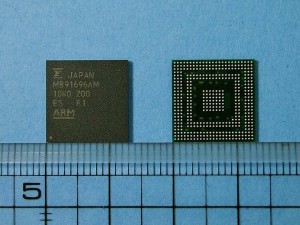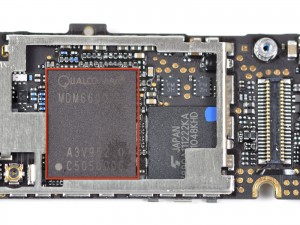September 6th, 2012 ~ by admin
Back in 2010 we did a write up on the many processors in each iPhone for each version through the iPhone 4. Since then Apple has released the iPhone 4 (CDMA) and the mid-cycle refresh iPhone 4S. Seeing as the iPhone 5 should be released on September 12th here is a quick update to bring our table up to date.
CPUs by function and generation of iPhone:
| Function |
2G |
3G |
3GS |
4 |
4-CDMA |
4S |
| App Processor |
Samsung S3C6400 400-412MHz ARM1176JZ |
Samsung S3C6400 400-412MHz ARM1176JZ |
Samsung S5PC100 600MHZ ARM Cortex A8 |
Apple A4 800MHz ARM Cortex A8 |
Apple A4 800MHz ARM Cortex A8 |
Apple A5 900Mhz Dual core ARM Cortex-A9 |
| Baseband |
S-GOLD2 ARM926EJ-S <200MHz |
Infineon X-Gold 608 ARM926 312MHz + ARM7TDMI-S |
Infineon X-Gold 608 ARM926 312MHz + ARM7TDMI-S |
X-Gold 618 ARM1176 416MHz |
Qualcomm MDM6600 ARM1136JS 512MHz |
Qualcomm MDM6610 ARM1136JS 512MHz |
| GPS |
NA |
Infineon HammerHead II |
Infineon HammerHead II |
BCM4750 (no CPU core) |
see above |
see above |
| Bluetooth |
BlueCore XA-RISC |
BlueCore XA-RISC |
BCM4325 (2 CPU cores) |
BCM4329 (2 CPU cores) |
BCM4329 (2 CPU Cores) |
BCM4330ARM Cortex-M3 + Bluetooth CPU |
| Wifi |
Marvell 88W8686 Feroceon ARMv5 128MHz |
Marvell 88W8686 Feroceon ARMv5 128MHz |
see above |
see above |
see above |
see above |
| TouchScreen |
Multi-chip |
BCM5974 |
TI |
TI |
TI |
TI |
| OS |
Nucleus by Mentor Graphics |
Nucleus |
Nucleus |
ThreadX by ExpressLogic |
REX by Qualcomm |
REX by Qualcomm |
| Total Cores |
5 |
7 |
7 |
5 |
5 |
6 |
Apple iPhone 4 CDMA
The CDMA version of the iPhone 4 switched from an Infineon X-Gold baseband to a Qualcomm MDM6600 running a 512MHz ARM1136JS core. Interestingly this baseband supports GSM but due to antenna issues it is not implemented here. The Qualcomm Gobi, as it is known, also has integrated GPS, removing the need for the old Broadcom BCM4750. This sets the stage for the iPhone 4S.
Read More »
February 14th, 2011 ~ by admin
The last week has been filled with new processor announcements, mainly for phones, but cameras as well. (yes they run some powerful processors now too).
TI is barely shipping products with its dual-core OMAP 4 applications processor and has already announced its successor, the OMAP 5. The OMAP 5 will be a 2GHz dual core ARM Cortex-A15 (the next ARM generation after the A9). It also includes a pair of ARM Cortex-M4 processor. the Cortex-M4 is a 150-300MHz microcontroller oriented processor. This will allow the OMAP 5 to run basic background tasks on the slower (lower power) cores while reserving the high power cores for tasks that actually need them, increasing battery life.
Broadcom continues its drive to enter the smart phone business with the BCM28150, a 1.1GHz dual core ARM Cortex-A9 compatible with Google Android. In December they released the BCM2157, a 500MHz dual core ARM11 processor for low-end smart phones
Samsung decided to rename the Orion processor (announced back in November) to the Exynos 4210. A bit of a mouthful compared to Orion.

Fujitsu MB91696AM
Qualcomm showed off the APQ8060 in HP’s new TouchPad. This is a dual core version Snapdragon processor we have become very familiar with. Qualcomm has an architecture license from ARM so they are free to design their own cores without having to stick to ARMs own implementations (such as Cortex-A9 etc). This gives Qualcomm more flexibility to design in features they need, and tweak design more best efficiency.
Smart phones aren’t the only ones getting new processors. Digital cameras now require immense amount of processing power (especially to handle 1080p video recording. Fujitsu (yah, they still make a lot of processors) announced the Milbeaut MB91696AM. This is a dual core ARM processor with many other DSP functions capable of handling 14Mpixel shooting at 8fps, as well as full HD video.
February 8th, 2011 ~ by admin
After years of waiting Apple has released the CDMA version of the iPhone 4. Obviously the first carrier that comes to mind with the CDMA iPhone (and who it is being released with) is Verizon. However, the largest CDMA carrier in the world, with over 90 million subscribers, is China Telecom. One can imagine this is also going to be a pretty good market for Apple. The design is relatively the same as the GSM version with one major change. The baseband processor has been changed from an Infineon X-Gold 618 to a Qualcomm MDM6600. This is a pretty big detriment to Intel, who purchased Infineon’s wireless unit just last year. You can see the specs of the GSM iPhone 4 here, as well as all previous iPhones.

Qualcomm MDM6600 - 512MHz ARM1136 - image: iFixit
The MDM6600 (Gobi) is actually a GSM/CDMA solution, but due to antenna limitation (is anyone surprised?) it is built for CDMA only. Once again this is an ARM powered chip. The MDM6600 main core is a 512MHz ARM1136JS. The X-Gold 618 of the GSM iPhone 4 runs a 416MHz ARM1176. The ARM1136 is roughly the same as the 1176 with a few features removed.
This is good news for Apple, and certainly good news for ARM as millions of more devices with ARM processor cores will be sold. It will be interesting to see which baseband provider Apple selects for the iPhone 5 which should support 4G.
November 18th, 2010 ~ by admin
Snap! Just 4 days after we posted about next generation Applications processors Qualcomm has announced the next version of the Snapdragon, the MSM8960. They are moving to a 28nm process (likely TSMC or Global Foundries) and of course dual cores. Qualcomm is also promising a 5x performance increase, which means they are likely reworking the Scorpion core and likely adding Out-of-Order Execution which offers a significant speed boost. Graphics speed will also be increased with an updated Adreno graphics core. The other important detail is that the MSM8960 supports all 3G and LTE modes, making it a single chip solution for pretty much the entire world market. It also, of course, integrates bluetooth, wifi, and GPS.
This should put Qualcomm in a very competitive position against the Tegra 2, OMAP4, and the new Samsung Orion.
All of this at a 75% reduction in power levels. Suddenly my HTC Incredible, isn’t.



